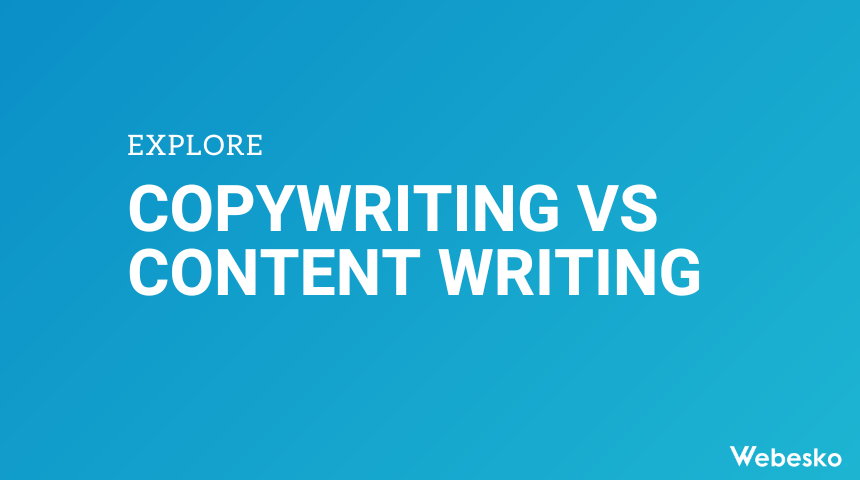Copywriting vs Content Writing: Understanding the Difference and Formats

Effective writing is the backbone of online communication. Whether you’re crafting captivating ads or publishing engaging blogs, writing plays a vital role in connecting with audiences. This brings us to two widely spoken terms in the world of writing—copywriting and content writing.
While they might seem similar, these forms of writing serve different purposes and require distinct approaches. Let’s break down the difference between copywriting and content writing, and explore the typical format of content writing.
What Is the Difference Between Copywriting and Content Writing?
Although the terms “copywriting” and “content writing” are often used interchangeably, they cater to unique goals and audiences. Here’s a closer look at how they differ.
Purpose
- Copywriting
Copywriting is all about persuasion. Its goal is to drive action, whether that’s clicking a link, signing up for a newsletter, or purchasing a product. Copywriters craft concise, compelling text to convert readers into customers.Example platforms for copywriting include:- Google Ads and Facebook campaigns.
- Sales pages and product descriptions.
- Email subject lines with actionable intent.
- Content Writing
Content writing focuses on providing value and building relationships with readers. The aim isn’t immediate sales but fostering trust and engagement through relevant, informative, or entertaining content.Common formats include:- Blog posts.
- Informative articles.
- Tutorials, guides, or FAQs.
Tone and Style
- Copywriting usually employs a direct and high-impact tone, using urgency and emotion to encourage decision-making.
- Content Writing adopts a more educational, conversational, or storytelling tone, focusing on delivering value to the reader over time.
Length
- Copywriting tends to be shorter due to its immediate call-to-action approach. For instance, an ad headline like “Save 30% Today Only!” is concise but effective.
- Content Writing usually involves longer pieces, like blog posts or articles, that offer in-depth information. For example, a blog about “Top 10 SEO Tips” may be over 1,000 words.
SEO Application
While both forms utilize SEO principles, content writing often focuses more heavily on search engine optimization. Writers incorporate keywords naturally throughout blog posts, driving organic traffic and improving rankings. On the other hand, copywriters may use SEO in areas like ad captions or meta descriptions but focus more on attracting users through catchy phrases.
Quick Comparison Table
| Feature | Copywriting | Content Writing |
|---|---|---|
| <strong class=”font-bold”>Goal</strong> | Persuade and convert | Educate and engage |
| <strong class=”font-bold”>Formats</strong> | Ads, sales pages, email headers | Blogs, guides, long-form articles |
| <strong class=”font-bold”>Tone</strong> | Direct, persuasive | Informative, conversational |
| <strong class=”font-bold”>Length</strong> | Short and impactful | Longer and detailed |
The Content Writing Format
Now that we’ve defined content writing, let’s discuss its format. Following a structured approach can help you ensure professionalism and clarity in your content.
1. Headline
The headline is the first thing your audience sees, so it needs to grab attention. Make it clear, concise, and intriguing. A good headline example includes “Top 5 Travel Tips to Save Money on Your Next Trip.”
2. Introduction
The introduction sets the tone and hooks readers. Use a relatable question, interesting fact, or bold statement to keep people reading. Avoid beating around the bush—state the value of your content upfront.
3. Main Body
The main body is where the magic happens. Structure the content into sections with subheadings, making it easy to read and digest. For example:
- Use bullet points and numbered lists where helpful.
- Incorporate examples to clarify complex ideas.
- Support points with data, statistics, or quotes.
4. Tone and Style
Content writing should cater to the audience. An informal, friendly tone works well for a lifestyle blog, while a formal tone suits industry-specific content like white papers.
For example:
- Casual tone: “Ever wondered why your plants keep dying? We’ve got you covered!”
- Professional tone: “The key components of effective project management include…”
5. Call-to-Action (CTA)
Content writing often includes a subtle CTA at the end. For instance, at the end of a blog, you might encourage readers to “Subscribe for more tips” or “Share your thoughts in the comments below.”
6. Length and Readability
Length depends on the topic and audience, but blog posts typically range from 800 to 2,000 words. Prioritize readability by using:
- Short sentences and paragraphs.
- Headings and subheadings.
- Active voice.
Copywriting vs Content Writing in Practice
To summarize, copywriting and content writing serve unique needs:
- If you want to run an ad or improve eCommerce conversions, hire a copywriter.
- If you need to educate your audience with blogs or guides, focus on content writing.
Whichever route you choose, both writing types can elevate your business when used effectively. Tailor your approach based on the message you want to convey and the goals you wish to achieve.
By understanding their differences and formats, you can leverage content to build trust while using copy to seal the deal. Know your audience, choose your strategy wisely, and watch your writing make an impact.


